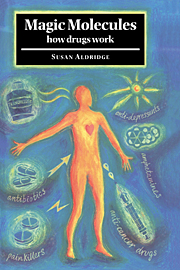Book contents
- Frontmatter
- Contents
- List of illustrations
- Acknowledgements
- Introduction
- 1 How drugs work
- 2 From penicillin to Prozac: introducing pharmaceutical drugs
- 3 Fighting infection
- 4 The hormonal revolution
- 5 Cardiovascular drugs: protecting the heart and brain
- 6 The problem of pain
- 7 The cancer challenge
- 8 Drugs for the mind
- 9 Drugs of recreation and addiction
- 10 Natural alternatives: vitamins, minerals and herbs
- 11 In the pipeline: gene-based medicine
- Bibliography
- Index
10 - Natural alternatives: vitamins, minerals and herbs
Published online by Cambridge University Press: 05 August 2012
- Frontmatter
- Contents
- List of illustrations
- Acknowledgements
- Introduction
- 1 How drugs work
- 2 From penicillin to Prozac: introducing pharmaceutical drugs
- 3 Fighting infection
- 4 The hormonal revolution
- 5 Cardiovascular drugs: protecting the heart and brain
- 6 The problem of pain
- 7 The cancer challenge
- 8 Drugs for the mind
- 9 Drugs of recreation and addiction
- 10 Natural alternatives: vitamins, minerals and herbs
- 11 In the pipeline: gene-based medicine
- Bibliography
- Index
Summary
As we saw in the last chapter, people can choose to take drugs for nonmedical reasons. Here we review the way people take non-drugs for medical reasons. These non-drugs are mostly classified – at least in the UK – as food supplements. Unlike the pharmaceutical drugs discussed in other chapters, these are mostly substances found naturally in the human diet, such as vitamins and minerals. Herbal extracts are also increasingly popular, and although many of these would not normally find their way into the average Western diet, they are still classified as food supplements.
The reason for this classification is to avoid taking the products through the development and testing processes described in Chapter 2. Often this is a reasonable choice; most of these products have been in use for hundreds of years, so clinical testing can be regarded as having been done – albeit in an informal way. So if vitamin C, one of the most popular supplements, were in any way seriously toxic we should have heard about it by now.
Pharmaceutical companies, on the whole, are unlikely to take on the licensing of any vitamin, herb or related product. Their long tradition of use means that they cannot be patented and therefore companies will not be able to gain back finance invested in development from royalties. This leaves manufacturers of these ‘natural’ medicines free to promote their products, although they may not advertise these as if they were licensed drugs. Compare the detailed description of a prescription medicine with the vague wording on a packet of vitamin C or evening primrose oil to see the difference several million pounds of research and development makes.
- Type
- Chapter
- Information
- Magic MoleculesHow Drugs Work, pp. 227 - 240Publisher: Cambridge University PressPrint publication year: 1998



